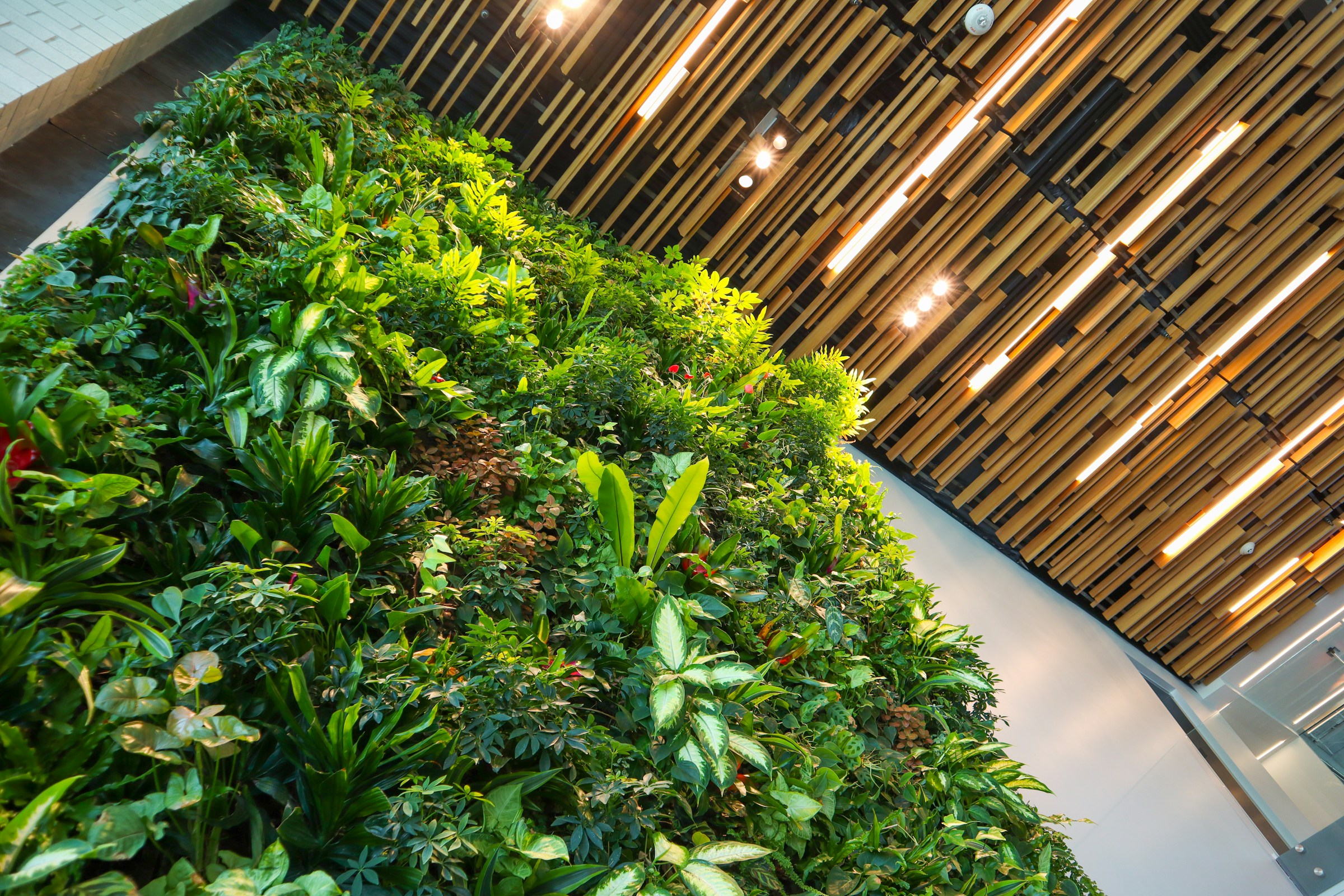What's the Best Method to Create a Sustainable Living Wall in a UK Office?

In today's fast-paced world, we often find ourselves in urban jungles made of concrete and glass. But what if we could bring a piece of nature into our daily environment, especially within the confines of our office walls? Enter the concept of a living wall. A concept that is not only environmentally friendly but also aesthetically pleasing.
A living wall, or green wall, is a vertical garden that is attached to both the interior or exterior of a building. It is a fantastic way to incorporate a touch of greenery into urban spaces. But how do we create a sustainable living wall in a UK office? This article will explore this question in detail, taking into account factors such as design, plant selection, irrigation, and maintenance.
Sujet a lire : How to Design a Low-Energy Water Feature in a UK Eco-Garden?
Designing a Living Wall for an Office Space
Before you start bringing in plants and soil, it's crucial to have a good design plan in place. The design of your living wall will depend on several factors, including the size and shape of your office space, the amount of natural light available, and the climate of your location.
Start by assessing the space you have available. Consider the wall's exposure to air and light, as well as how well it can support the weight of the wall system. Depending on the wall size, living walls can weigh between 30 to 40 kgs per square meter once saturated with water.
Cela peut vous intéresser : Which Foliage Plants Are Most Effective for Purifying Air in UK Homes?
As for the design itself, it can range from a simple pattern of one or two plant species to a complex mural of various plants. Engage a professional landscape designer if you want a more complex design, as they'll understand how to create a visually appealing wall that also meets the plants' needs.
Choosing the Right Plants for Your Living Wall
The plants you choose for your living wall can dramatically affect its look and feel. In choosing your plants, consider their mature size, growth rate, and light requirements.
You also need to consider the office environment. Some plants are better equipped for indoor settings, able to thrive in lower light and with less frequent watering. Plants such as the Pothos, Peace Lily, and Snake Plant are known for their hardiness and adaptability, making them ideal candidates for a living wall in an office.
Plant selection also plays an essential role in maintaining healthy indoor air quality. Some plants are known for their air-purifying properties, removing harmful toxins from the environment. Spider plants, for example, are renowned for their ability to improve air quality.
Setting Up an Efficient Irrigation System
Water is essential for the survival of your living wall. However, watering a vertical garden is not the same as watering a horizontal one. It requires an efficient irrigation system that ensures all plants receive an adequate supply of water.
There are various irrigation systems that you can use, including drip irrigation, hydroponic, or even manual watering. Drip irrigation is often the most preferred system, as it delivers water directly to each plant's root zone, minimizing water wastage.
Keep in mind that the irrigation system you choose will also depend on the type of living wall system you're using. For example, if you're using a panel system filled with soil, drip irrigation may be ideal. However, for a hydroponic system where plants are grown in water rather than soil, a recirculating system may be more appropriate.
Ensuring Proper Maintenance of Your Living Wall
A living wall is not a set-it-and-forget-it kind of project. Like any garden, it needs routine maintenance to keep it healthy and attractive. This includes watering, fertilizing, pruning, and occasionally replacing plants as necessary.
Ensure your office has a maintenance plan in place. This plan should include regular checks to ensure the irrigation system is functioning well and that the plants are receiving adequate water. If you find certain plants aren't doing well, don't hesitate to replace them. This is a normal part of maintaining a diverse living wall.
Remember to also routinely check for pests and diseases. Early detection and treatment are key to preventing any potential issues from spreading to the rest of the wall.
Appreciating the Benefits of a Living Wall
Living walls are more than just aesthetically pleasing. They offer numerous benefits, including improved air quality, enhanced employee well-being, and reduced energy costs.
Numerous studies have shown that plants can help reduce stress and improve productivity in the workplace. They can also help to dampen noise, creating a more peaceful and calming work environment.
On a larger scale, living walls contribute positively to the environment by absorbing carbon dioxide and releasing oxygen. They can also help to reduce energy costs by providing natural insulation, reducing the need for heating in winter and cooling in summer.
Overall, a living wall is a worthwhile investment for any office. They transform our working environments into healthier, more attractive spaces. They remind us of our connection to the natural world, even as we work within our concrete jungles.
Deploying a Biophilic Design Approach for Living Walls
Biophilic design, which is the practice of incorporating nature into the built environment, is an approach worth considering when creating a living wall. This approach recognises the inherent human need to connect with nature, and designs are made to honour and reflect this connection.
Biophilic design goes beyond just adding plants to a space. It involves considering the textures, patterns, materials, and spatial configurations that occur in natural landscapes. Living walls are a perfect example of biophilic design, as they can mimic the vertical layering found in many natural ecosystems.
The vertical structure of a living wall can be designed to support a variety of plant species, creating a dense and diverse representation of nature. Different plants can be arranged to create patterns or gradients, replicating the dynamic variety found in nature.
The incorporation of moss walls within the living wall design can also add depth and textural contrast, making the wall more visually intriguing. Moss walls are not only an interesting design feature, but they also have excellent sound-absorbing properties, contributing to a more calming and peaceful environment.
Incorporating a biophilic design approach when creating a living wall can result in a more immersive and enriching experience. It can offer workers a sense of connection to the natural world, even within an urban office setting.
Case Studies of Successful Living Walls in UK Offices
Case studies of successful living walls in UK offices provide valuable insights into the practical aspects of creating and maintaining a green wall. They demonstrate the benefits green walls can bring to the workplace, such as improved air quality and enhanced employee well-being.
An excellent case study is the living wall installed in the London office of the global advertising agency Wieden+Kennedy. This wall spans two floors and includes over 6,000 plants. The wall was designed to increase biodiversity and create a healthier work environment. Post-installation surveys reported improved employee satisfaction and decreased sick days.
Another example is the energy company Ecotricity, whose headquarters in Stroud features an impressive living wall. This vertical garden not only improved air quality but also reduced energy costs by providing insulation. Staff reported feeling more relaxed and productive in their green-filled work environment.
These case studies demonstrate the substantial gains to be made from investing in a living wall. They also highlight the importance of a well-thought-out design, the use of suitable plants, an efficient irrigation system, and regular wall maintenance.
In Conclusion
Living walls are a transformative addition to any office. They not only enhance the aesthetic value of the workplace but also bring numerous health and environmental benefits. The process of creating a living wall requires careful design and planning, selection of suitable plants, installation of an efficient irrigation system and ensuring regular maintenance.
Taking a biophilic design approach can make your living wall not just a feature, but an integral part of your office's identity. By closely examining case studies, we can learn from successful implementations and avoid potential pitfalls.
Though they require an initial investment of time and resources, living walls eventually pay off by improving employee morale and productivity, delivering air purification, and reducing energy costs. They are a clear demonstration of a company's commitment to sustainability and employee well-being.
In a world where urbanisation is rapidly increasing, living walls represent a powerful way to reconnect with nature and create healthier, more inspiring workplaces. The shift towards green wall designs is not a trend but a movement towards a more sustainable and harmonious way of living with nature.
